What is the 'open decision framework' that Red Hat, a Linux business successor, cares about in operating an organization?

Red Hat (Red Hat) , which sells and supports the Linux distribution 'Red Hat Enterprise Linux', develops products with engineers distributed. Jim Whitehurst, CEO of Red Hat, one of the world's most successful Linux businesses, often asks, 'How do you compile the opinions of engineers at dispersed locations into a single project?' It will be done. Therefore, ' Open Decision Framework ' that Red Hat values is released as a presentation material. It reveals that an open decision framework consists of five principles: 'open discussion,' 'participatory,' 'meritocracy,' 'community,' and 'quick and frequent releases.'
Red Hat Releases the Open Decision Framework to Spur Transparent and Inclusive Leadership
' Open Decision Framework ' (Updated June 2, 2016)
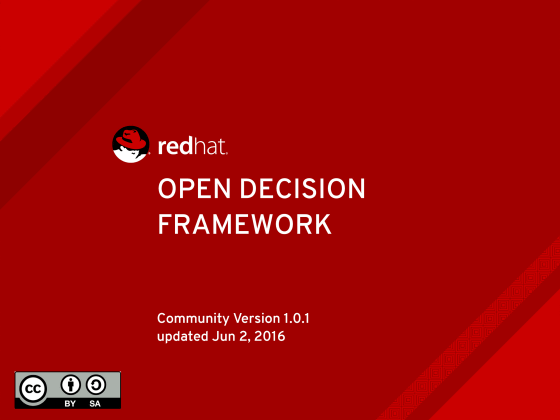
◆Outline
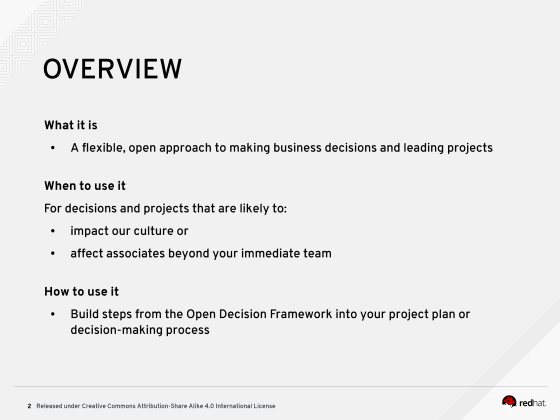
・What is the Open Decision Framework?
'A flexible and open approach that is necessary for business to make decisions and guide projects.'
・When do you use it?
When making decisions that can have a major impact on corporate culture or can affect members beyond the current team.
・How do you use it?
Gradually use the Open Decision Framework by dropping it into a project proposal or decision-making process.
◆ What is 'Open Decision'?
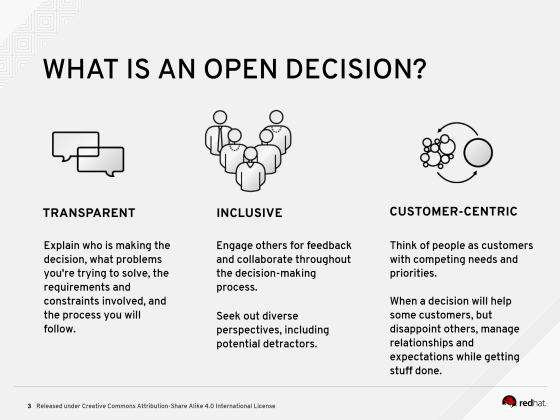
・Transparent
Explain 'who makes the decision?' 'what are the problems and constraints that should be solved?' and 'the process to take'
・Inclusive
Collaborate with others to get feedback and collaborate throughout the decision-making process. Seeking diverse perspectives (which may include potential slander)
・Customer-Centric
Think about competitive needs and priorities for your customers. Decisions for one customer can sometimes cause disappointment for another customer. Therefore, efforts should be made to maintain the relationships and expectations of the actions of the parties concerned.
◆ Open Decision is based on the principle of open source
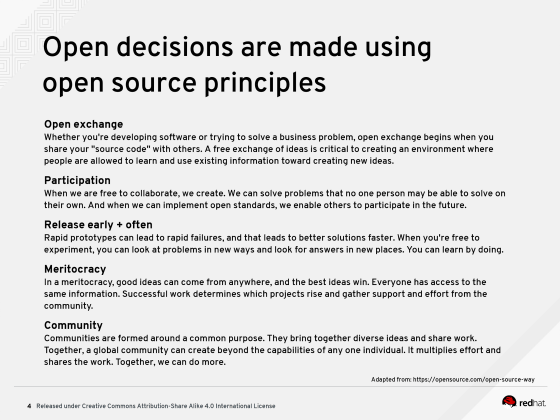
・Open exchange
Whether developing software or solving business problems, you need to exchange 'source code' with others. An environment where new ideas can be created from existing information is created by free exchange of ideas.
·Participatory
If you can cooperate freely, you can solve problems that cannot be solved by yourself. Everyone can participate only by creating an open environment.
· Release quickly and often
Prototyping quickly leads to the quick identification of obstacles, which in turn leads to faster solutions. If you have a free trial environment, you will be able to see the problem from a new perspective and answer from a new perspective. Much can be learned from trials.
・Meritocracy
Under meritocracy, the 'best idea' wins, regardless of who came up with the idea. And everyone is allowed to access the same information.
·community
Communities are formed by a common purpose. Communities bring ideas and collaboration. Global communities create possibilities that transcend individual capacities, double effort, and divide labor. You can get more done by working together.
◆ What is the flow of open source principles leading to good decisions?
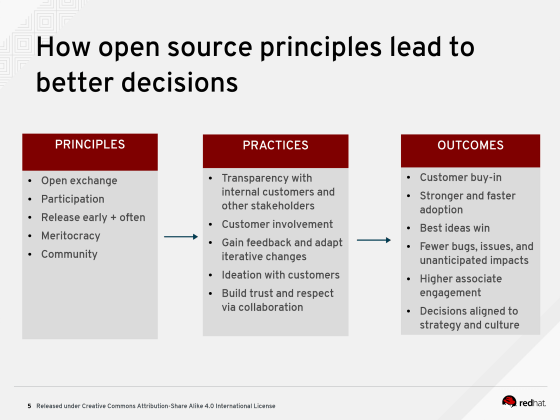
·principle
'Open exchange' 'Participatory' 'Quick and frequent releases' 'Meritocracy' 'Community'
↓
・Practice
'Transparency for customers and stakeholders' 'Customer involvement' 'Responding to feedback appropriately' 'Building ideas with customers' 'Ensuring trust and respect through collaboration'
↓
·Outcome
'Purchase' 'Strong and quick approval' 'Excellent idea wins' 'Bugs and unexpected trouble suppression' 'High engagement' 'Strategy and corporate culture-based decision'
◆ It is impossible to satisfy everyone. By all means, 'open decision making'
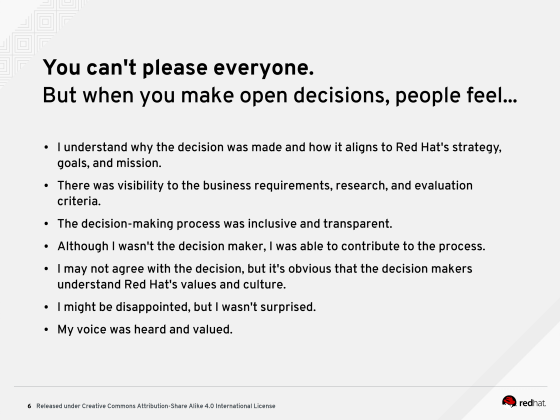
If the decision is 'open'...
・Understand why that decision was made and what the Red Hat strategy, goals and mission are.
・It is possible to ensure transparency in business regarding requirements, surveys, and evaluation criteria.
・If the decision-making process is open and transparent, it is possible to control the decision-making process even without the right to make decisions.
• Even if you may not be happy with your decision, it is clear that the person who made the decision understands the value and corporate culture of Red Hat.
・You may be disappointed, but there is no surprise in the unexpected situation.
・Listen to and be evaluated.
◆ Stage of “invention”
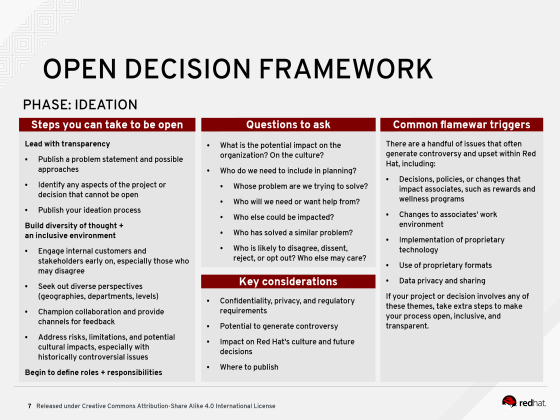
・Means to take
transparency
'Open problems and possible ways' 'Identify what cannot be opened' 'Publish devising process'
Build diversity of ideas and environment
'Involve customers and stakeholders who disagree in particular' 'Search for diverse perspectives' 'Claim good ideas and get feedback' 'Write down risks, limitations and potential impacts'
Start to clarify roles and responsibilities
・Questions to ask
'What is the potential impact on the organization and culture?'
'Who is needed at the design stage?'
Who's problem
Who needs help
Who is involved
Who has solved a simple problem
Who disagrees and who agrees
'Key considerations'
Requests for confidentiality, privacy, regulations, etc.
Potential for discussion
Impact on Red Hat's corporate culture and future decisions
Where to publish
・Common framework triggers
Issues that cause discussion and confusion within Red Hat
Reward
Change the working environment
Implementation of original technology
Use Preferred Format
Data privacy sharing
If the decision process includes the above issues, then many steps should be taken to make the process open.
◆ “Planning + survey” stage

・Means to take
Engage customers and researchers
Gather the views of customers and those who need services
Ask what functions you use often
Open new information
Establish an individual route other than the official route for obtaining opinions
Give a prediction
Clarify what feedback you are looking for
Articulate the decision process and project plan
Explain clearly
Frequent disclosure of project and decision ranges
Identify the factors that influence decisions and their relative importance
Reveal survey results
Reveal legal matters and concerns
Plan a fix
Gather feedback, discuss and modify plan as needed
Think about the confusion caused by changes
・Question to be answered
How to make a decision
Which customers and stakeholders are affected
How to get them in
What are open source options
What is priority
Could you choose your own format
What would conflict with Red Hat's value and culture?
· Key considerations
Who is affected and how often
Who and how to be strong
Roles and responsibilities
◆ 'Design/Development/Test' stage
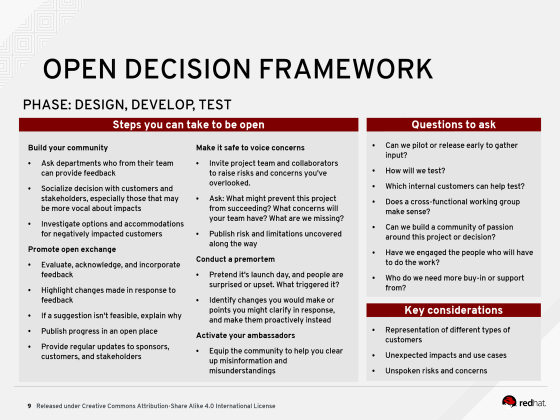
・Steps to open
Community building
Ask the department to give feedback to the team
Communicate decisions to customers and stakeholders
Investigate options and follow negative impacts
Promote open discussion
Rate feedback
Reveal changes from feedback
If the proposal is not feasible, explain why
Announce results in public
Reassure your concerns
Invite project team members to highlight risks and issues
What are the obstacles to the success of the project? What are the problems your team might have? What are you overlooking? Ask
Identify risks and limitations
Activate participants
Prepare the community to correct any information or misunderstandings.
・Question to be answered
Can you expedite testing or release?
How to test
Which customers are likely to help with the exam
Is it possible to create an enthusiastic community around projects and decisions?
Who needs to sell more services
· Key considerations
Representatives of different types of customers
Unexpected impact
Risks and concerns not discussed
◆ “Launch” stage
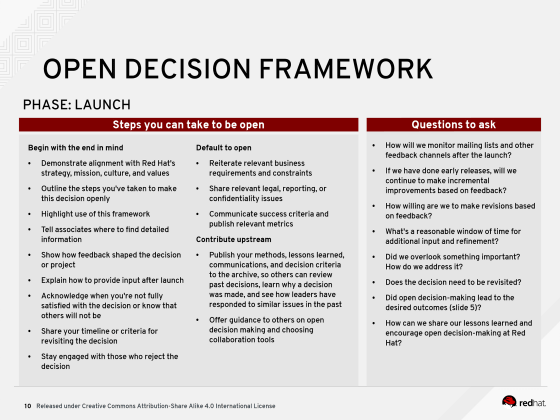
・Steps to open
Think from the end
Ensure consistency with Red Hat's strategy, mission, corporate culture and values
Clarify the steps you have taken to make that decision
Tell where to find more information
Reveal how feedback shaped decisions and projects
Explain how to provide feedback after a release
Demonstrate understanding that some people are not satisfied with their decisions
Make an ongoing effort to bring in those who oppose the decision
Practices for opening
Repeat relevant things about business requirements and restrictions
Share relevant laws, press and confidentiality
Discuss a successful crisis and related standards
Reward
Documenting methods, lessons learned, learning, communication, etc. so that others can look back on their decisions
Advise the process by which open decisions were made
・Question to be answered
How to get feedback after the release and browse the mailing list
Can feedback be further improved?
Can you be happy to fix your feedback?
Have you overlooked something important?
How to deal with oversights
Do you need to rethink your decision?
Did open decision perform as expected?
How to share lessons
How to encourage Red Hat's open decision process
Related Posts:
in Note, Posted by darkhorse_log







